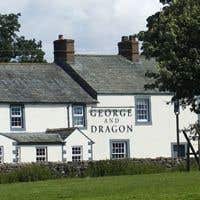This article was also published in the Financial Times.
Shortly after I married my Cumbrian wife 30 years ago, I learnt of two particular challenges that continue to face chefs in this particularly verdant county that stretches from the southern Lake District to the Scottish border.
The first is that size matters. Cumbrians, I learnt, do not like to see the plate underneath whatever dish they have ordered: the food has to be substantial. And however well they have eaten, there is invariably a hefty appetite for dessert, the part of any meal that is most critically judged in this far north-western corner of England.
I was reminded of these two distinctive traits shortly after I had ordered a half pint of Ruskin's bitter at the bar of the George and Dragon, a pub and restaurant with rooms just south of Penrith in Clifton, where the last battle was fought on English soil in 1745.
As I looked around the crowded room, I watched as three young men were studiously preparing for the following day's wet outing on their mountain bikes by devouring huge steaks. Behind them the blackboard revealed that this could only be Cumbria: after the three first and main course specials there were four dessert specials.
What distinguished the food further became obvious as we were taken through to the restaurant, full of chairs and pews from an old church, and were handed the menu. While the right-hand side contains a brief list of tempting dishes, the left comprises a hand-drawn map of the Eden Valley detailing the various locations of all the farmers, fishermen and suppliers to the kitchen. At the centre was an outline of Lowther church and castle that has belonged to the Lowther family for centuries, part of the large estate on which their Game & Country Fair takes place on 11-12 August.
The cooking was, however, distinctly modern. A wild rabbit terrine packed lots of flavour while a gravad lax of sea trout with beetroot was lighter and brighter. A fillet of sea trout as a main course was excellent and an introduction to pan haggerty potatoes, an old northern recipe that incorporates layers of thin potatoes, root vegetables, onions, local cheese and herbs, a dish so good that I will definitely cook it at home.
If the desserts, particularly the lemon posset, had not been as good as they were, then the George and Dragon would certainly not have prospered since its conversion from an old coaching inn by Charlie Lowther and chef Paul  McKinnon (centre) in 2008. But two other factors distinguished our stay. The first was the enthusiastic service from a bevy of attractive young women, led by Chloe Marshall, matched by the aesthetic appeal of the building, for which the artist Juno Lowther, Charlie's wife, is responsible.
McKinnon (centre) in 2008. But two other factors distinguished our stay. The first was the enthusiastic service from a bevy of attractive young women, led by Chloe Marshall, matched by the aesthetic appeal of the building, for which the artist Juno Lowther, Charlie's wife, is responsible.
I learnt this last fact from McKinnon the following morning when I sat down with him after a hearty breakfast. I had had to wait a few minutes while he chatted with his mother, who had called in for a coffee, an interlude that allowed me to discover that he had not grown up with good food. His interest was confined to eating cream puffs, she recalled, while he countered that she had only really been a whizz with microwave chips. He eventually took to cooking as an alternative to the army.
Fortunately, he learnt his trade in Newcastle under the highly talented chef Terry Laybourne before a disastrous move to Carlisle where he opened his own restaurant and promptly lost £75,000, his entire savings. McKinnon had to begin again at the bottom, cooking for dinner parties in the area, and this was how he came to the attention of Charlie Lowther.
McKinnon is as enthusiastic about what the George and Dragon represents as he is garrulous and adamant that an important part of what he has to do is to ensure that there is an overall harmony between his kitchen team and his waiting staff. And while he is justifiably proud of the consistent quality level the restaurant has reached so far, what brought the biggest smile to his face was explaining how Danny Keeley, a young recruit they had taken in as a dishwasher when he was homeless, had recently been made young apprentice of the year by the local college.
The George and Dragon's popularity has given Lowther and McKinnon the confidence to transform an even older building right at the heart of the estate: Askham Hall Gardens, next to the castle, that was until recently an old byre. Today, it is a comfortable and hugely atmospheric café while a whole new area outside has been created for the cattle, pigs and chickens that are being reared, alongside the fruit and vegetable gardens, to supply the kitchens. It is the kind of bucolic scene that would bring an enormous smile to the face of Alice Waters of Chez Panisse, California, or Carlo Petrini, the founder of the Slow Food Movement.
But in one very significant aspect this café is particularly Cumbrian. Right by the café entrance is a pizza oven that has just been built from local stone by Alf Armstrong, putting the local craft of dry-stone walling that is such a distinctive feature across the Cumbrian hillside to a new purpose.
McKinnon explained how Armstrong had initially come to work in the kitchen before discovering this particular skill. This restaurant and cafe are now not only providing typical Cumbrian hospitality but also giving new life to some very old and distinctive buildings.
George and Dragon, Clifton, Nr Penrith, Cumbria CA10 2ER; tel 01768 865381
www.georgeanddragonclifton.co.uk
Askham Hall Gardens, Askham CA10 2PF; tel 01931 712348
www.askhamhall.co.uk

